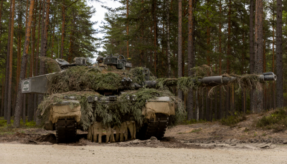
By Neil Fraser, Director Defence and Space Programmes, NSSLGlobal
In the new era of multi-domain operations, hybrid warfare and grey zone adversaries, greater flexibility and resilience in tactical edge communications has become critical. This article draws on some of the conversations I have had with people from industry and the defence user community, along with briefings I have been at, including around the lessons from Ukraine and how they should perhaps reshape our thinking about battlespace connectivity.
Whether it is senior defence speakers, academics with deep research under their belt, or people in the industry, most agree that Ukraine has clearly demonstrated the danger of reliance on one form of network connectivity. The long-established approach of seeking a full PACE plan to step through (primary, alternate, contingency, emergency), which has been a key tenet of military communications planning for generations, has seen new capabilities added, such as Low Earth Orbit (LEO) satellite communications (satcom) and greater integration of commercial services into a more dynamic PACE approach to mitigate the increased threats to networks.
This shift in approach is not just about the battlespace in Eastern Europe. The significant changes in defence doctrine among many NATO nations now emphasise more open technical architectures, more dynamic and flexible tasking and re-organising in deployments and decentralised control for greater effectiveness and survivability in many different settings.
Current and future deployments of land forces are likely to be more widely dispersed, operating at greater range and with smaller units, massing only when needed for a specific task and then re-dispersing, and thus more reliant on robust connectivity. More complex tasks across any sensor to any effector, necessitates faster access to digital information if force elements are to achieve superiority and offset reduced mass with improved situational awareness, more rapid decision making and focused lethality, all while operating in a more challenged electromagnetic spectrum (EMS).
At the same time, all maritime, land and air forces want to implement AI-driven technologies to achieve transformative levels of automation and efficiency. Machine Learning (ML) and by extension Artificial Intelligence (AI) is playing a key role in the rapid evolution of frontline threat detection and battlefield robotics. Almost all AI advances depend on connectivity with the cloud, either reaching back or through tactical “combat clouds” along with “edge compute” to leverage a mass of contextual and localised data.
Communications have become more complex with the growing sophistication of military systems and the need to access and share information securely, without interruption. To enhance resilience and accelerate the pace and improve the effectiveness of decision making in complex situations, forces must operate as hyperconnected entities. Whether in mass or dispersed in small units, forces require higher levels of resilient connectivity.
The lesson of Ukraine
The 24 February 2022 Russian cyber-attack on the KA_SAT satcom network of Viasat,1 impacted windfarms and consumers but also threatened Ukraine’s ability to operate effectively. It was however also satellite connectivity that most publicly overcame this vulnerability and enabled the Ukrainians to coordinate operations against Russian forces and rapidly innovate in their use of drones. Clearly, the conflict has illustrated how essential satcom has become at the tactical edge alongside terrestrial systems. Units need more than one type of network, and they must be able to respond to network threats.
Starlink has proved to be a reliable commercial solution in Ukraine, leveraging multiple satellites that have proved hard to jam while rapidly developing patches to mitigate threats. However, from conversations and the media there have also been lessons around the assurance of service, and how services can be used and potentially restricted at a time of need. Hence the PACE plan approach is key not just technically, but commercially, and relying on one operator or technology is to operate at risk.
Beyond the Starlink solution, many other satcom networks have also been widely used, both narrowband such as satphones, and broadband leveraging both LEO and GEO capacity along with terrestrial networks and meshed radio networks.
So, while forces need to avoid preparing to fight the last war and focus on the next one, lessons from Ukraine have shown a vastly different technical and tactical environment from the campaigns in Iraq and Afghanistan. Operations in those theatres were in a dispersed but largely unchallenged electronic environment. Ukraine, in addition to trials and development work in several nations, has also clearly shown that much of what is needed to radically improve capabilities in the short term is already in the hands of service personnel or in the market somewhere.
In the next piece, Neil will discuss the diverse connectivity on land and how lessons from past conflicts have shaped current communication needs.







